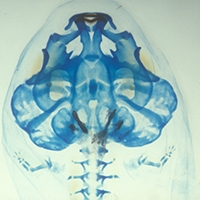Citation:
| 4.48 MB |
Date Published:
MayAbstract:
Phenotypic variation is a prerequisite for evolution by natural selection, yet the processes that give rise to the novel morphologies upon which selection acts are poorly understood. We employed a chemical genetic screen to identify developmental changes capable of generating ecologically relevant morphological variation as observed among extant species. Specifically, we assayed for exogenously applied small molecules capable of transforming the ancestral larval foregut of the herbivorous Xenopus laevis to resemble the derived larval foregut of the carnivorous Lepidobatrachus laevis. Appropriately, the small molecules that demonstrate this capacity modulate conserved morphogenetic pathways involved in gut development, including downregulation of retinoic acid (RA) signaling. Identical manipulation of RA signaling in a species that is more closely related to Lepidobatrachus, Ceratophrys cranwelli, yielded even more similar transformations, corroborating the relevance of RA signaling variation in interspecific morphological change. Finally, we were able to recover the ancestral gut phenotype in Lepidobatrachus by performing a reverse chemical manipulation to upregulate RA signaling, providing strong evidence that modifications to this specific pathway promoted the emergence of a lineage-specific phenotypic novelty. Interestingly, our screen also revealed pathways that have not yet been implicated in early gut morphogenesis, such as thyroid hormone signaling. In general, the chemical genetic screen may be a valuable tool for identifying developmental mechanisms that underlie ecologically and evolutionarily relevant phenotypic variation.
Notes:
134QRTimes Cited:5Cited References Count:72






